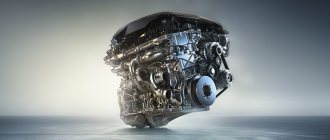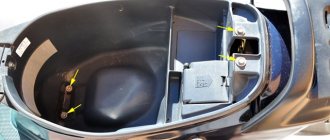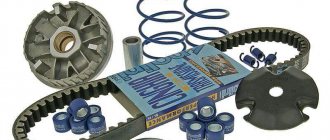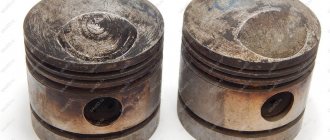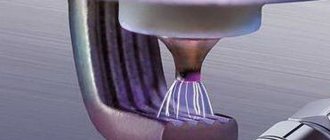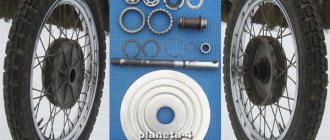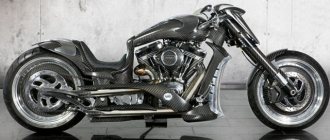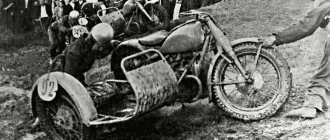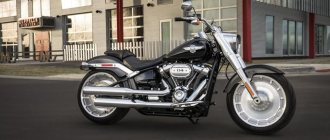Izh Planeta-5 is one of the popular brands of motorcycles. But over time, the vehicle breaks down. Often the piston fails. You can buy this part in Russia for an amount from 800 to 7000 rubles .
The piston on Izh Planet-5 is an element of a motorcycle engine that perceives the pressure of gases formed during the combustion of fuel and transmits force to the connecting rod mechanism . In two-stroke engines, this part also serves as a gas distribution mechanism.
Failure of the piston on Izh Planeta-5 may be due to natural wear, improper operation, or violation of the installation rules for this part. The piston must be positioned strictly in the engine cylinder. The joints of the piston rings must not fall into the openings. Otherwise, breakdown cannot be avoided.
Factors influencing the price level
The cost of a motorcycle piston varies from place to place. This is due to the consideration of certain factors in the price. When developing a price list, implementers take into account the following:
- State.
- Manufacturing company.
- Originality.
- Quality.
- The fame of the implementer.
- Place of purchase.
- Delivery required.
The better the condition of the part, the higher its price will be . The more famous the manufacturing company, the more expensive its products will be. You will have to pay separately for delivery of goods. Some companies deliver products for free within a city or region. In other cases, the delivery price depends on the distance between the buyer and the seller. The higher the quality of the part, the more it will cost. Original spare parts are valued higher than non-original ones.
Why does the gap between the piston and cylinder change?
Car designers strive for engine parts to operate in fluid friction mode.
This is a method of lubricating rubbing surfaces when, due to the strength of the oil film or the supply of oil under pressure and at the required flow rate, direct contact of the parts does not occur even under significant load.
On the subject: How to understand that the cylinder head gasket is broken
This state cannot always be maintained and not in all modes. Several factors influence this:
- oil starvation, the supply of lubricating fluid, as is done in the sliding bearings of the crankshaft and camshaft, under pressure into the area between the piston and cylinder is not carried out, and other lubrication methods do not always give a stable result; special oil nozzles work best, but for various reasons they put them up reluctantly;
- a poorly made or worn honing pattern on the surface of the cylinder, designed to hold the oil film and prevent it from completely disappearing under the force of the piston rings;
- violations of the temperature regime cause the thermal gap to zero, the disappearance of the oil layer and the appearance of scuffing on the pistons and cylinders;
- the use of low-quality oil with deviations in all significant characteristics.
It seems counterintuitive, but the cylinder surface wears more, although it is usually made of cast iron, a solid cast iron block or various dry and wet liners cast into the aluminum of the block.
Even if there is no liner, the surface of the aluminum cylinder is subjected to special treatment, and a layer of a special hard wear-resistant coating is created on it.
This is due to a more stable pressure on the piston, which, in the presence of lubricant, almost does not remove metal from it during movement. But the cylinder is subject to rough operation of spring rings with high specific pressure due to the small contact area.
This is interesting: How to check the camshaft position sensor DPRV
Naturally, the piston also wears out, even if this happens at a slower rate. As a result of the total wear of both friction surfaces, the gap continuously increases, and unevenly.
Varieties
Motorcycle pistons come in different types. They are sorted after production into certain groups. The difference between categories can be about 0.01 mm . The pistons have their own markings. There are the following types of pistons for Izh Planet-5:
- "1". The cylinder diameter is 71.99 mm and the piston diameter is 71.94 mm .
- "0". The cylinder has a diameter of 72 mm , and the piston has a diameter of 71.95 mm .
- "00". Piston diameter - 71.96 , cylinder - 72.01 mm .
- "000". The piston has a diameter of 71.97 mm , the cylinder - 72.02 mm .
The condition of the item may be:
- New, in excellent condition.
- New, with a manufacturing defect.
- Used, in good or fair condition.
- Used, in poor condition, with defects.
Local purchases can be made:
- In a specialized market.
- In a specialty store.
- By private advertisement.
- At the vehicle dismantling point.
- In the online store.
Spare parts for Izh Planet-5 are available according to the manufacturer:
- Original.
- Unoriginal.
Buy in the online store, best prices, inexpensive delivery
On an Izh Jupiter 5, engine repair is not a tricky matter, and let’s boil it down to the main points: If it is necessary to replace the cylinder heads, determine the amount of protrusion of the piston bottom above the upper plane of the cylinder liner when the piston is at the top. Depending on this, select the cylinder head of the appropriate group according to the table
The group number is indicated on the plane of the horizontal edge of the head from below.
Pistons and cylinders. The amount of wear is determined by measuring the diameters of the pistons and cylinders. If the gap between the piston and cylinder is more than 0.3...0.4 mm, they need to be repaired. Repair is also necessary if the cylinders have deep marks and burrs on the working surface. Repair of the Izh Jupiter 5 engine is usually carried out:
* selection and installation of new sets (of normal size) of cylinders, pistons and piston rings to replace worn ones or * boring and honing of old cylinders and installation of rings and pistons of repair sizes. When replacing pistons and cylinders, select the same group according to the table
The piston group marking is on its bottom, and the cylinder group marking is on the upper flange. In order to distinguish parts from those previously produced with a nominal cylinder diameter of 61.75 mm, the groups are marked with numbers in a circle. The piston diameters shown in the table are measured at a distance of 21 mm from the bottom end. Install piston rings of normal size. The diameter of such a ring with a gap at the joint of 0.2…0.4 mm is 62.03+0.05 mm. When installing repair pistons, the cylinders must be bored and honed to a size that provides radial clearance between the cylinder and the piston: 0.01-0.03 mm for an oval-barrel-shaped piston and 0.06-0.08 mm for a cone-cylindrical piston. Ovality and taper along the entire length of the cylinder is 0.03 mm, no more. Spare parts are supplied with pistons and piston rings of two repair groups according to the table
The piston repair group is marked by stamping on its bottom, the piston ring group is marked by colored enamel on its inner diameter near the joint.
Piston pins and connecting rod upper head bushing. When installing a new piston (nominal or repair sizes), select the piston pin using the holes in the bosses. The pins and holes of the bosses are marked in different colors depending on the repair groups according to the table
The color of the piston pin markings must match the color of the piston markings. The pin group is marked in enamel on its inner diameter near the end, and the piston is marked on the boss inside the piston.
In case of wear of the holes in the bosses and the bushing of the upper head of the connecting rod, you can install a repair-size pin by reaming the holes for it, according to the table below.
Spare parts include pins from two repair groups. If the connecting rod upper head bushing is worn, replace it with a repair size bushing or a bushing made of bronze according to the figure.
Press out and press in the bushing according to the figure.
A - pressing using a vice: 1 - vice, 2 - mandrel, 3 - bushing, 5 - bushing of the connecting rod upper head.
B - pressing out using a bolt: 1 - bolt, 2 - connecting rod, 3 - bushing, 4 - washer, 5 - nut, 6 - bushing of the upper head of the connecting rod, 7 - ring.
B - pressing in the connecting rod upper head bushing: 1 - bolt, 2 - connecting rod, 3 - washer, 4 - nut, 5 - connecting rod upper head bushing, 6 - ring.
After pressing, unroll the bushing hole using a special sliding reamer. The inner diameter of the bushing should be 0.036...0.07 mm larger than the diameter of the pin, and when installing a pin of normal diameter - 14.036+0.027 mm. Clean the ends of the bushing on both sides flush with the upper head of the connecting rod.
Piston rings. Install new piston rings when replacing (repairing) pistons and cylinders or in cases where the piston and cylinder have acceptable wear, and the gap measured with a feeler gauge at the joint of the ring installed in the cylinder at a distance of 10...30 mm from the top end is more than 2.5 mm . Before installing a new ring you must:
* insert the ring into the cylinder and use a feeler gauge to determine the gap at the joint of the ring; in a new cylinder this gap should be 0.2...0.4 mm; if the gap is smaller, file the ring at the joint; * install the ring into the cylinder with the joint in the direction corresponding to the working position, and using the light of a lamp, determine its fit to the cylinder; the contact between the ring and the cylinder can be continuous or point-like (in the form of a dotted line). Clearance is allowed no more than 10% of the circumference, except 15° from the lock on each side. To finalize the outer surface of the ring, grinding is allowed; * check the mobility of the ring in the piston groove; The piston ring gap in the groove should be 0.075...0.102 mm, and the ring should move freely in the groove without jamming. Remove carbon deposits from the piston grooves with a special solution (Appendix 4); if there is no solution, use a scraper.
Assembly. Place the rings onto the pistons using the plates, aligning their locks with the piston pins. Install a retaining ring into the bore groove of one of the piston bosses, and an oil-lubricated piston pin into the hole of the opposite boss. Place the piston onto the upper end of the connecting rod with the arrow pointing backwards so that the piston ring locking pins point forward in the direction of travel of the motorcycle. Align the holes of the bosses and the bushings of the upper head of the connecting rod and, holding the piston with your hand, press in the piston pin using a mandrel and light blows of a hammer. Install the second retaining ring into the piston. Install the second piston. Check the parting surfaces before installing the cylinder and clean them if necessary. Install sealing gaskets made of spacer cardboard or paronite on the parting plane. Place a wooden stand (plate) under the piston, lubricate the cylinder bore with oil, place the cylinder on the piston and studs, carefully threading the piston rings. Remove the stand and, moving the cylinder, set it in place and secure it. Make sure that the ring locks do not get into the cylinder windows. Reinstall the second cylinder, then the carburetor pipe with gasket and the cylinder heads. Tighten the fastenings of the heads and pipe in the following order: tighten the two middle screws securing the carburetor pipe until they stop. Then the two outer bolts. To ensure a tight fit on the cylinder heads, tighten the nuts evenly in a crisscross pattern.
Right crankshaft oil seal, clutch control mechanism. For ease of disassembly, repair and assembly of these assembly units without removing the engine from the frame, it is recommended to disconnect the right and left mufflers and rod from the foot brake lever.
Result of clearance violation
As the gap increases, and usually it is also associated with a deterioration in the performance of the rings, more and more oil begins to penetrate into the combustion chamber and is wasted.
Theoretically, this should reduce compression, but more often, on the contrary, it increases, due to the abundance of oil on the compression rings, sealing their gaps. But this doesn’t last long, the rings coke, lie down, and compression disappears completely.
Pistons with increased clearances will no longer be able to work normally and begin to knock. The piston knock is clearly audible on the shift, that is, in the upper position, when the lower head of the connecting rod changes the direction of its movement and the piston passes the dead center.
The skirt moves away from one wall of the cylinder and, choosing a gap, hits the opposite wall with force. You can’t drive with such a ringing noise; the piston may collapse, which will lead to a disaster for the entire engine.
